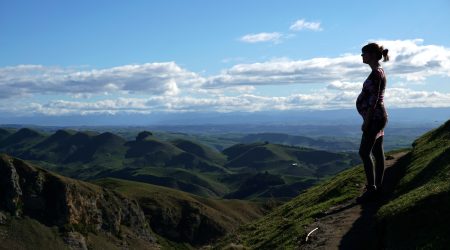Te Mata Peak
Om de hoek ligt Te Mata Peak, een heuvel (in Nederland zouden we zeggen: berg) van bijna 400 meter.
Als ik naar mijn werk fiets, moet ik 1 lange weg uitfietsen, die een doorkijkje biedt op deze heuvel. Als het zonnig is, helder zichtbaar, als het bewolkt is soms in nevelen gehuld – elke keer een andere sfeer, eigenlijk altijd mooi. Zoals bij vrijwel alle karakteristieke onderdelen van het landschap is aan Te Mata een prachtige Maori legende verbonden. Hieronder het verhaal in het Engels (afkomstig van deze website)…
The well-recited legend of Te Mata Peak protrays the hill as the prostrate body of the chief Rongokako, the grandfather of Kahungunu and ancestor of all iwi of Ngāti Kahungunu.
Many centuries ago the people living in pa (fortified villages) on the Heretaunga Plains were under constant threat of war from the coastal tribes of Waimarama. At a gathering at Pakipaki (5km south of Hastings) to discuss the problem, the solution came when a kuia (wise old woman) sought permission to speak in the marae: “He ai na te wahine, ka horahia te po,” she said. (The ways of a woman can sometimes overcome the effects of darkness).
Hinerakau, the beautiful daughter of a Pakipaki chief, was to be the focal point of a plan. She would get the leader of the Waimarama tribes, a giant named Te Mata, to fall in love with her, turning his thoughts from war to peace. The plan succeeded but she too fell in love.
The people of Heretaunga, however, had not forgotten the past and with revenge the motive, demanded that Hinerakau make Te Mata prove his devotion by performing seemingly impossible tasks. The last task was to bite his way through the hills between the coast and the plains so that people could come and go with greater ease.
Te Mata died proving his love when he choked on the earth of Te Mata Peak and today his half-accomplished work can be seen in the hills in what is known as The Gap or Pari Karangaranga (echoing cliffs). His prostrate body forms Te Mata Peak.
At sunset one can often see, in the mists which stretch from the crown of Kahurānaki, the beautiful blue cloak with which the grieving Hinerakau covered the body of her husband before leaping to her own death from the precipice on the Waimarama side of the Peak. The gully at the base of the cliff was formed when her body struck the earth.
Looking towards the Peak from Hastings, the huge bite that choked Rongokako can be seen. The outline of his body forms the skyline, with his head to the south and his feet to the north. The Peak was then known as Te Mata O Rongokako meaning “The Face of Rongokako”, but has been shortened to the more familiar Te Mata Peak over time. European settlers also thought the hills resembled a man lying down and called him the “Sleeping Giant”.
Daarnaast heb ik zondag als correspondent nog een bijdrage geleverd aan het radioprogramma De Wereld van BNN: over een rugbyrel, scholen en iconische deuntjes. De fragmenten die te horen zijn in het laatste onderwerp komen van YouTube: klik voor het liedje Poi E hier en de Haka van het WK 2011 hier.
En als laatste, zoals altijd: de foto’s!

Toch wel een traditionele rolverdeling: draagmoeder en draagvader.
Nice! Beetje jammer dat je werd afgekapt voor China! En nogmaals, respect voor Annelieke haar sportiviteit! Hoe gaat de draagverdeling tas vs kind zijn als de kleine er eenmaal is? Of is dat nog niet besloten?
Blijf schrijven!